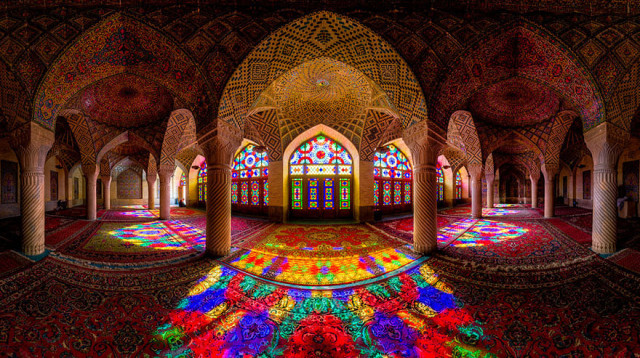The wonders of Islamic architecture
Iran especially, is known for its extraordinary collection of stunning mosques

The ceilings of mosques in particular are a focal point of mosques. Islamic architecture draws heavily on mathematics and geometry, especially in the Arab world.
The repeating perfect spirals and geometric forms are reminiscent of the intricate mandalas found in Buddhist art as well. Iran especially, is known for its extraordinary collection of stunning mosques.
Read: Red Juma Mosque opens after 90 years in Russia
Here's a look at some of the mosques:
Wazir Khan Mosque, Lahore
The mosque is famous for its extensive faience tile work. It has been described as 'a mole on the cheek of Lahore'.
Wazir Khan mosque was built in seven years, starting around 1634–1635 AD, during the reign of the Mughal Emperor Shah Jehan.

PHOTO: SALMAN ARIF
Bahaud-din Naqshband Mausoleum, Bukhara, Uzbekistan
The Mausoleum of Saint Bakhouddin Naqshbandi is one of the most important shrines for Muslims. Believers from different muslim countries come here to ask for healing and for their wishes to be fulfilled.
The complex also includes the museum, which keeps the true information about Sufi and Sufism; Sufi wearing, books and other expositions.

PHOTO: ZAK WHITEMAN
Al Soltan Qalawoon Mosque
The mosque is located in the capital city of Egypt.

PHOTO: ABDELRAHMAN ASSEM
Fatima Masumeh Shrine
The shrine of Fatima Masumeh is situated in Qom, Iran. Thousands of Shia muslims travel to Qom every year, to honour Fatima and seek her blessings.

PHOTO: FATIMA MASOUMEH

PHOTO: IMGUR.COM
Nasir al Mulk Mosque
Located in Shiraz, Iran, Nasir al Mulk Mosque is also known as the 'pink mosque.' The mosque uses coloured glass in its facade, and also displays other traditional elements in its design.

PHOTO: RAMIN RAHMANI NEJAD

PHOTO: MY2200

PHOTO: MOHAMMAD REZA DOMIRI GANJI

PHOTO: MY2200

PHOTO: MOHAMMAD REZA DOMIRI GANJI
Sheikh Lutf Allah Mosque
Standing on the eastern side of Naghsh-i Jahan Square, Isfahan, Iran, this mosque is known to be one of the is one of the architectural masterpieces of Safavid Iranian architecture.

PHOTO: ALI KORDZADEH

PHOTO: WIKIMEDIA.ORG
Vakil Mosque
Vakil Mosque in Shiraz, Iran, was built in mid eighteenth century with its interior and the gates decorated with tiles in floral patterns. The mosque has only two iwans instead of the usual four.

PHOTO: MOHAMMAD REZA DOMIRI GANJI
Shah Mosque
Shah mosque was renamed Imam mosque after the Islamic Revolution. Located in Isfahan, the mosque is regarded as one of the masterpieces of Persian Architecture and an excellent example of Islamic era architecture of Iran.

PHOTO: MOHAMMAD REZA DOMIRI GANJI
Jalil Khayat Mosque
Jalil Khayat mosque in Arbil, Iraq has walls built of bricks while the internal walls and ceiling are decorated with colorful Zakhrafa (Islamic special painting), scripts of Holy Quran verses, and huge ceiling lamps.
Experts from Turkey, Egypt, and other countries worked on the project.

PHOTO: KARAM
Sheikh Zayed Grand Mosque, Abu Dhabi, UAE
Sheikh Zayed Grand Mosque was initiated by the late president of the United Arab Emirates (UAE), Sheikh Zayed bin Sultan al Nahyan, who wanted to establish a structure which united the cultural diversity of Islamic world as well as the historical and modern values of architecture and art.
His final resting place is located on the grounds beside the same mosque.
Constructed in 1996 to 2007, the mosque is the largest mosque in the UAE.

PHOTO: HABIB Q
Taj Mahal mosque ceiling
Located in Agra, India, Taj Mahal is a white marble mausoleum which took nearly 22 years to build with around 20,000 artisans and craftsmen working throughout the empire.
Construction of Taj Mahal began in 1632 on the orders of Shah Jahan, a Mughal emperor who was grief-stricken as his wife Mumtaz Mahal died during child birth.

PHOTO: EBURGH
Grand Mosque of Isfahan, Isfahan, Iran
The Grand mosque, also known as Jameh mosque of Isfahan is the grand, congregational mosque of Isfahan city, within Isfahan Province, Iran.
The mosque is the result of continual construction, reconstruction, additions and renovations on the site from around 771 to the end of the 20th century.

PHOTO: ALI KORDZADEH
This article originally appeared on Bored Panda



















COMMENTS
Comments are moderated and generally will be posted if they are on-topic and not abusive.
For more information, please see our Comments FAQ